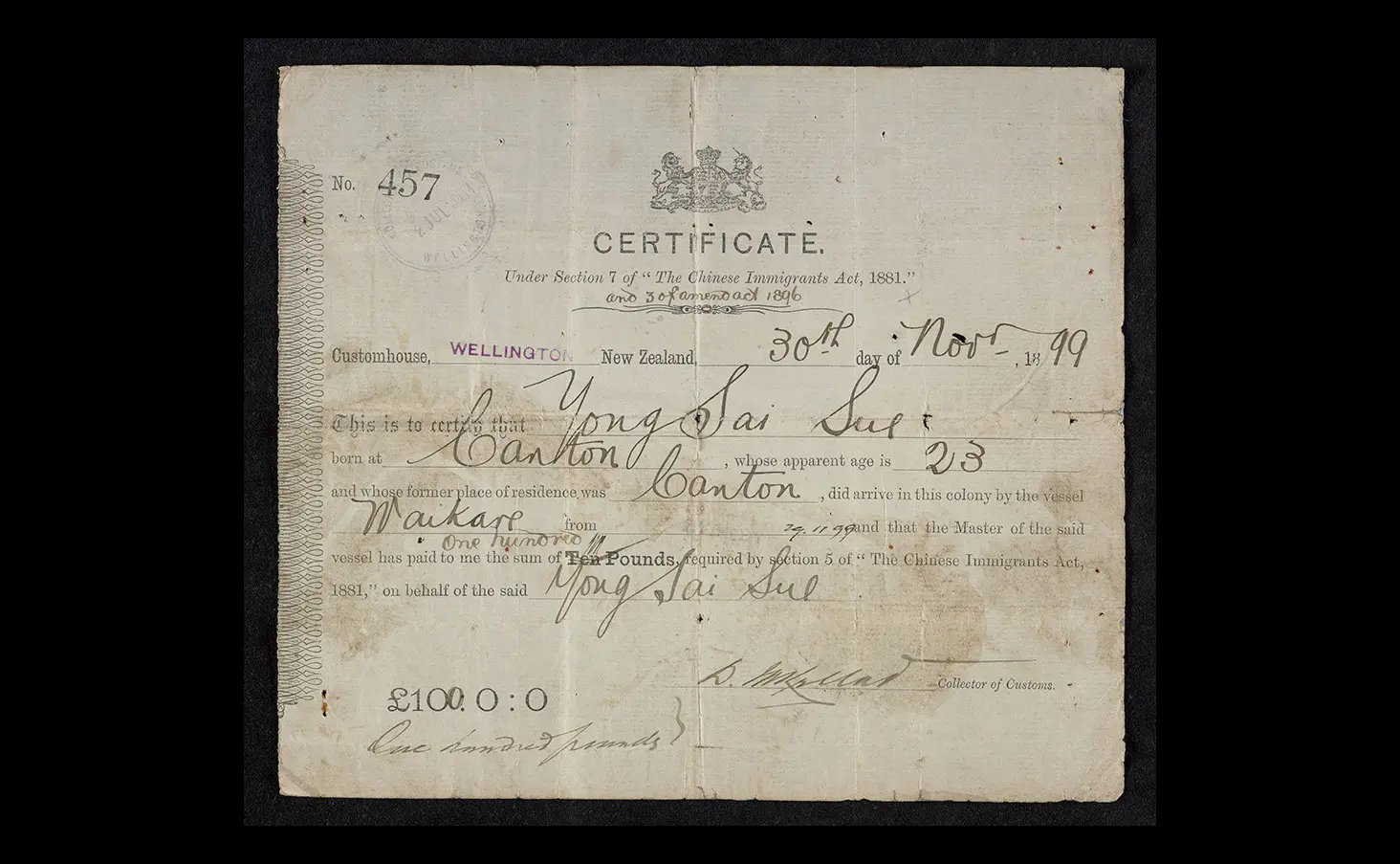Image credit: Poll tax certificate for Yong Sai Sue, Canton (Guangzhou), arrived Wellington, 30 November 1899. Ref: MS-Papers-7724_003 Alexander Turnbull Library.

Image credit: Poll tax certificate for Yong Sai Sue, Canton (Guangzhou), arrived Wellington, 30 November 1899. Ref: MS-Papers-7724_003 Alexander Turnbull Library.

Chinese migrants began arriving in Aotearoa during the 1860s, many finding work in the goldfields. Racial prejudices soon saw restrictions, such as a poll tax, placed on these immigrants. Find out more by exploring our collections and curated resources.
Chinese people were the first ethnic group to have their immigration into New Zealand restricted by the government, including the burden of a poll tax. Chinese migrants first began arriving in numbers in the 1860s, invited by the Otago Chamber of Commerce, which encouraged them to seek employment on the South Island goldfields. By the 1870s, anti-Chinese prejudice was developing among other immigrants, and claims that the Chinese were taking over their jobs, bringing diseases into the country and not assimilating into the local culture were common.
Prejudice bred a political issue, and in 1881 Parliament passed the Chinese Immigrants Act, which introduced a poll tax of £10 per Chinese migrant. The Act also imposed a restriction on ship passengers — one Chinese passenger per 10 tons of cargo. In 1896, the tax was increased to £100 per person (equivalent to a year’s wages for a labourer) and further restrictions were placed on the number of Chinese migrants able to enter New Zealand. Between 1882 and 1930, an estimated 4500 people paid the tax.
If a Chinese migrant wished to visit China and planned to return to New Zealand to live within four years of departure, they were required to complete an exemption certificate. The traveller would keep one section of the certificate, while a magistrate kept the other for immigration records.
Chinese migrants were the main target of discrimination by the state, but immigration services also looked unfavourably on other ethnic groups. In 1906, 361 immigrants in New Zealand had registered as being born in Syria. The certificate of registration shown below relates to the registration of the Khouri family from Syria. The form had been developed for Chinese people, and so ‘Syrian’ has been substituted for ‘Chinese’. From 1908 onwards, certificates included tighter controls, such as fingerprinting and identification photographs, as in the example shown here.
The Chinese Immigrants Act was repealed in 1944, although it wasn’t until 1952 that the government once again allowed Chinese immigrants to become New Zealand citizens. In 2002, Prime Minister Helen Clark made a formal apology to those Chinese people who had paid the poll tax and suffered other discrimination imposed by statute, and to their descendants. The apology acknowledged the considerable hardship the tax had inflicted, and that its cost and the impact of other discriminatory immigration practices had split families apart.
In the 2018 Census, 247,770 respondents identified with the option of Chinese as an ethnic group.
Story written by: Seán McMahon and Lynette Shum
Copyright: Turnbull Endowment Trust
Image credit: Immigration re-entry registration certificate for Lily Khouri, aged 44 and her 3 children, 1910 by Edward William Sorrell. Ref: fMS-Papers-11659_001 Alexander Turnbull Library.

Explore the Alexander Turnbull Library collections further: Chinese in New Zealand.
Topic Explorer has Immigration to Aotearoa New Zealand.
Want to share, print or reuse one of our images? Read the guidelines for reusing Alexander Turnbull Library images.
Tikanga ā-iwi:
Te whakaritenga pāpori me te ahurea
Te ao hurihuri
Ngā mahinga ohaoha.
Te Takanga o Te Wā (ngā hītori o Aotearoa):
Whakapapa
Whanaungatanga.
Social sciences concepts:
Identity, culture, and organisation
Continuity and change
The economic world.
Aotearoa New Zealand’s histories:
Colonisation and its consequences
The exercise of power
Relationships and connections between people.